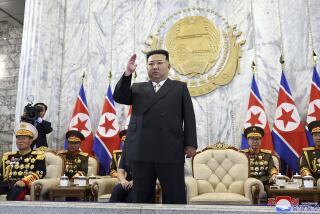PAGEANTRY : A Passage for India in Huge Annual Parade : The past comes to terms with the present in Republic Day festivities. Old regiments segue seamlessly into new weaponry.
- Share via
NEW DELHI — The pomp and pageantry of the Raj, the jewel in the British Empire’s crown, did not die with it. Each January, they glitter anew, albeit for just a morning, when one of the world’s great parades streams down the avenues of India’s capital.
You can tell much about a country from its public rituals. On Republic Day, the glories of India’s past segue seamlessly into its modern achievements and aspirations. For 80 minutes, the world’s most populous democracy celebrates itself with a show that boasts a cast of thousands.
Elephants lumber by applauding crowds, carrying Indian children who are being honored for acts of bravery. Musicians of the Border Security Force, claiming to be the world’s only camel-borne band, play their instruments from precarious perches on high humps.
Motorized floats document the charms of India’s states--this year, Goa’s tempting seafood, Portuguese-flavored brio and sunny beaches were one entry, the isolated Buddhist mountain enclave of Ladakh in Jammu and Kashmir another.
If anybody needs it, this nationally televised parade, shown for a second year throughout Asia on satellite TV, is an annual, multicolored reminder of India’s human and natural diversity.
*
But there’s serious content too, with the same goal that once compelled the Kremlin to flaunt its missiles and armor once a year on Red Square. For India, the Jan. 26 parade is an occasion to remind other countries--especially Pakistan, with which it has gone to war three times--that it has plenty of military muscle.
As South African President Nelson Mandela, this year’s guest of honor, watched with Indian leaders in the glassed-in VIP box, Soviet-model T-72 tanks in desert-style camouflage clanked down the broad thoroughfare called Rajpath. Low-flying arrowhead formations of Jaguars and MIG-29s streaked by in the first Republic Day fly-by in recent years.
India showed off its Prithvi surface-to-surface missile--a weapon whose deployment would fuel an arms race on the subcontinent, in the opinion of the Clinton Administration. And for the first time, the country’s indigenously produced Lakshya pilotless target aircraft was displayed.
Somewhat incongruously, all of this modern weaponry was trundled in front of a great custard-colored balloon made in the likeness of Mohandas K. (Mahatma) Gandhi, the apostle of nonviolence who once suggested that India should dump its arsenal into the sea.
For foreigners, whose visions of India may come from Hollywood costume epics, Republic Day is a sumptuous feast of uniforms and old warhorse units whose romantic names recall bygone days of empire-building.
As yet another surviving legacy of the Raj, small, tough Gurkha soldiers from the Himalayas furnished much of the parade’s soundtrack--by playing the bagpipes as long ago some Scots had taught their forefathers.
Unfortunately, the holiday elsewhere in India was shattered by tragedy. In disputed Kashmir state, bombs exploded at a stadium in the city of Jammu where people had gathered for Republic Day speeches and a parade. Seven people were killed, police said.
But in New Delhi, the sun was pleasantly warm, the mood festive and the event a reminder of how in India, the past always coexists with the new. In India, the scattering of flowers has long been a mark of an auspicious occasion. At the Republic Day parade, spectators were pelted with rose and marigold petals--from helicopters whirling overhead.
More to Read
Sign up for Essential California
The most important California stories and recommendations in your inbox every morning.
You may occasionally receive promotional content from the Los Angeles Times.













